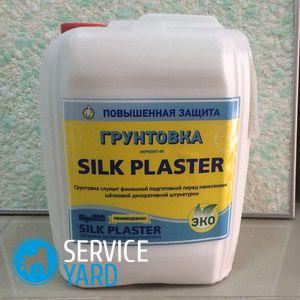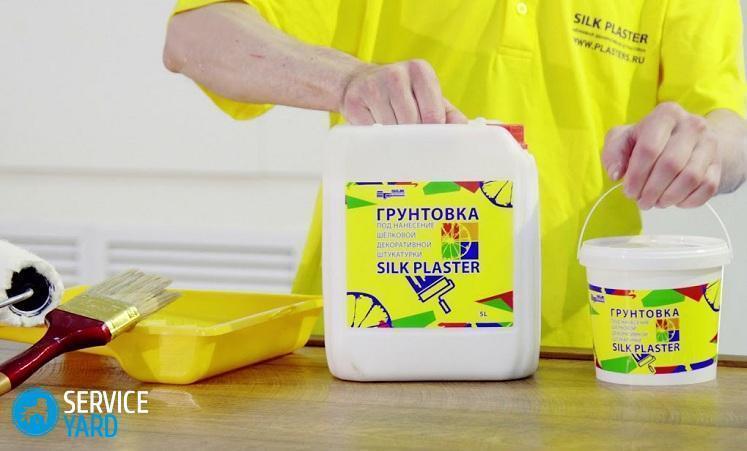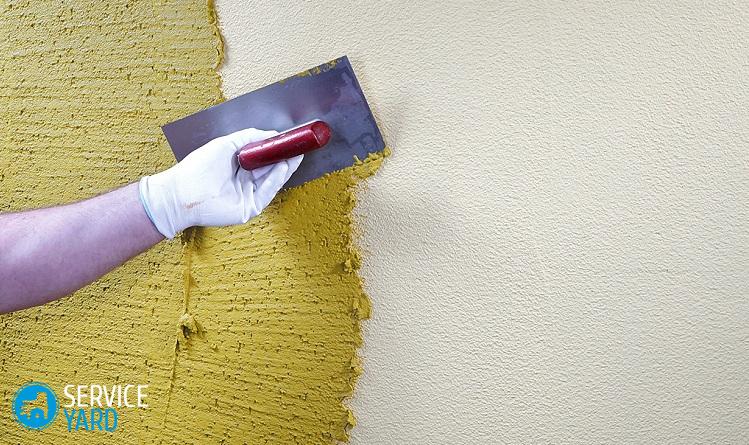Primer for liquid wallpaper

Liquid wallpaper is an expensive modern material for wall decoration, therefore, in order for the result to be perfect, it is necessary to observe the application technology in full. A primer for liquid wallpaper is needed without a doubt. This is not a marketing move designed to increase your spending on repairs, but a mandatory step in working with liquid facing mixes. In this article we will consider why a primer for liquid wallpaper is needed, what kind of primer is best for a high-quality result.
to contents ↑What is liquid wallpaper?
To understand whether soil is really needed for liquid wallpaper, first let's look at what liquid wall facing materials are.
This type of topcoat, although called “wallpaper,” is essentially a type of decorative plaster:
- A fluid is a cellulosic mixture containing a variety of decorative fibers.
Important! This material is also called silk plaster. But it differs from the real plaster in that it does not contain sand.
- The basis of the liquid is cellulose, a natural material with adhesive properties.
Important! Liquid decorative materials are sold in bags of different weights in dry and finished form. Before applying the dry mixture is diluted with the right amount of water according to the instructions.
- For beauty and shine, silk fibers, dyes, glitters, mother of pearl, mica, mineral chips and more can be added to the composition.
Important! The most durable, but also the most expensive are silk liquid wallpaper.
The advantages of liquid wallpaper:
- They can be used to decorate any complex surfaces of any kind (ledges, corners, arches, and so on).
- The surface comes out with a nice and smooth texture.
- There are no joints and seams on the surface, as when pasting with ordinary wallpaper.
- Liquid decorative mixes help smooth out minor surface defects.
- If necessary, you can easily restore individual damaged areas.
- During the work with them you have no waste and scraps.
- Due to its elasticity, cracks and tears will not appear on such a surface if you live in a new building, and the house gives some shrinkage.
- This type of finish enhances the noise and heat insulation of walls and ceilings, and it also regulates the amount of moisture in the room (in case of excess - it absorbs, in case of lack - it gives).
- Liquid “canvases” are safe, environmentally friendly and, as a rule, hypoallergenic.
So, liquid wallpaper is a beautiful and modern material, but in order for it to lie evenly and firmly held on the surface, preliminary preparation of the walls and ceiling before applying them is necessary. To do this, we apply a layer of soil.
to contents ↑Why is soil for liquid wallpaper needed?
There are several reasons for applying a primer during repair, and all of them are important:
- Primer for liquid wallpaper increases the adhesion of materials (walls, ceiling and liquid materials).
- It removes dust from the surface. Walls with a high cement content are always covered with dust, and this prevents the surface from adhering to the mixture of wallpaper. Soil “takes this dust upon itself”.
- The primer easily penetrates into all pores and microcracks of the base, fills them and forms a polymer film upon drying, which easily interacts with the decorative finish.
- Also, due to the filling of pores and cracks with soil, the consumption of liquid wallpaper per square meter is reduced.
- The soil becomes an intermediate layer between the wallpaper and the wall (ceiling), the color of the base is less visible.
- Soil prevents the formation of mold and mildew on the surface.
Based on the foregoing, priming extends the life of liquid wallpaper, contributes to high-quality application of the mixture and a flawless result.
to contents ↑Primer for liquid wallpaper. Which one to choose?
There are many types of soil, the choice depends on the type of surface on which decorative facing mixtures will be applied. Consider the main types of construction primers, suitable for use under liquid wall materials. So, how to prime the walls before pasting with liquid wallpaper?
Acrylic universal primer:
- Designed for a variety of reasons.
- It has no unpleasant odor, is easy to apply, and dries quickly.
- Such material penetrates well into the surface and reduces its absorption.
- It is inexpensive. But more suitable for dry rooms.
Important! Rust spots can penetrate the surface through the soil, so they need to be cleaned and covered with paint or alkyd enamel.
Acrylic deep penetration primer:
- Suitable for putty surfaces and drywall.
- Strengthens old walls with high absorbency, and is also suitable for rooms with high humidity.
Quartz primer (adhesive):
- Suitable for smooth walls that have low absorption. Usually it is concrete.
- On such surfaces, it is necessary to artificially increase adhesion, otherwise - liquid wallpaper will not hold. Quartz filler makes the surface rougher, thereby enhancing adhesion to the finish.
Alkyd Primer:
- Serves for coating wooden surfaces.
- It dries for a long time, about 15 hours.
Water repellents:
- Are applied to those surfaces from which moisture can get into liquid wall-paper.
- They are concentrated mixtures that must be diluted according to the instructions.
Do-it-yourself primer for liquid wallpaper
Many masters, on the question of how to prime the walls before gluing with liquid wallpaper, are advised to save money and make the soil with their own hands based on PVA glue and acrylic paint. There are several recipes:
- The mixture is prepared in proportion to one part of the glue to three parts of the emulsion.
- Based on PVA and water: 1 part glue and two parts water.
- Based on water and aqueous emulsion acrylic paint: 40% water, 60% paint.
Such options are attractive in terms of saving finances, especially when large areas are being finished, but in quality such mixtures are inferior to special solutions produced at the factory.
to contents ↑Important! Home-made soil does not penetrate deeper into the surface so well, it may crack and turn yellow over time (especially based on PVA), it may peel off due to its heavy finish, and it does not so much prevent mold and mildew.
Preparatory work before applying the primer:
In order to get a good result, you need to carefully prepare the surface. To do this, first of all, it needs to be cleaned of the old finish, plaster, paint and other things.
Important! It is recommended to apply a layer of antifungal coating or other antiseptic.
Remove all metal unnecessary elements, and if they do not lend themselves (caps from self-tapping screws on drywall, for example), you need to clean them from corrosion and cover with alkyd soil. This will prevent rust from flowing onto the surface of the liquid wallpaper.
to contents ↑Primed walls before applying liquid wallpaper
This process is simple. To do this, you will need a paint bath, a roller with a synthetic pile of medium length (preferably on a telescopic handle) and a brush for hard-to-reach spots:
- The mixture is prepared according to the instructions or well stirred if it is ready-made.
Important! Especially thoroughly need to knead the adhesive primer, as quartz dust constantly settles to the bottom of the tank.
- The roller is dipped from all sides into the mixture, the excess is removed, rolling it along the squeezing grate.
- Next, apply the composition to the surface. If it is a wall, you need to move from top to bottom, then all streaks are removed.
- Apply the composition in stripes, abundantly, trying not to miss a single plot.
- The soil is applied in several layers - everyone needs to be allowed to dry well. Depending on the type, it can take from 2 to 12 hours.
to contents ↑Important! If the surface is uneven, it can be additionally painted; this is usually done with an inexpensive white water-based paint, although it can be painted in tone with future wallpapers. For example, it is recommended to paint or shellac wood, as it has a heterogeneous color.
Stock footage
If you decide to decorate the walls with liquid wallpaper, and this is rather expensive, then you should not save on the primer, so that later you do not regret the efforts and finances spent, seeing the deplorable result on the walls. Which primer to use for liquid wallpaper is better? The answer depends on many factors, the main of which is the type of surface. Information from the article will help to understand the issues of choice and the nuances of applying the soil. Having decided on important aspects, you can easily choose the necessary goods in the store and quickly finish apartment renovation.
- How to choose a vacuum cleaner taking into account the characteristics of the house and coatings?
- What to look for when choosing a water delivery
- How to quickly create comfort at home - tips for housewives
- How to choose the perfect TV - useful tips
- What to look for when choosing blinds
- What should be running shoes?
- What useful things can you buy in a hardware store
- Iphone 11 pro max review
- Than iPhone is better than Android smartphones





